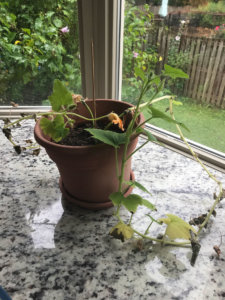Orchids to ogle next weekend
Mark your calendars for next weekend: That’s when the annual National Capital Orchid Society’s show and sale returns to dazzle us with one of the best free events in the area.
As it has for the past several years, the Orchid Extravaganza will be held at Behnke’s Nursery on Baltimore Avenue in Beltsville, Maryland, from Saturday, Oct. 6 through Monday, Oct. 8 (which is Columbus Day).
Now in its 71st year, you’ll see thousands of orchids on display and for sale. “Orchid doctors” will be on hand to diagnose what ails your particular plant, and educational talks are scheduled every day over this long weekend — and it’s all free.
Do not aerate soggy soil
Lee in Vienna writes: “I ordered core aeration, over-seeding and top dressing with compost for my lawn. The company was supposed to do it earlier this week but had to postpone due to all the rain. The next available time they can come is Oct. 22. My lawn could really use the aeration and top dressing, but is that date too late for the grass seed to germinate?”
It is far from ideal, Lee — but, they are absolutely correct about the aeration: It should not be performed on wet soil. My advice is to have the compost spread and have the over-seeding done now and postpone the aeration until next fall — or heck, even on their date in October if the soil is nice and dry then. There’s no law that says you have to aerate before seeding.
How to punish a pumpkin

Anne in Burke sings a sad song. She writes: “My daughter brought home a tiny pumpkin seed sprout from kindergarten in the spring, and we planted it in a pot and put it in a very sunny window, expecting nothing to come from it. Well, it took off and has really done well. However, it’s now almost October and I don’t see any pumpkins. I Googled and realized I made a number of mistakes, including not pollinating the flowers since it is indoors. Can I move it out to a garden bed in the spring for hope next year?”
Eh, no. The photo Anne sent shows a skinny stalk in a pot with a couple of branches, leaves and even flowers — and it’s only about 1/200 the size a pumpkin plant should be! (This is not a plant that “has done really well.”)
And, pumpkins are annuals, not perennials: This plant would not survive until next year. (Heck — it might not even make it through the night.)
This is a “goldfish goes to heaven” situation. Compost the poor should-have-been-a-pumpkin. Then, get a nice new pumpkin, start next spring and plant it where it will have lots of room to grow. Pumpkins take up a lot of room; they are the 800-pound gorillas of the garden.
When exactly is the offseason for skeeters?
Bill in Frederick County writes: “When should I start using BTI to deal with the mosquitoes. And, when is ‘mosquito season’ over?”
Great questions, Bill. Mosquito season is officially over with the first frost. The beginning is less clear. Hibernating females can emerge from their hiding places on unusually warm winter days, like one of those 70-degree weeks in January. But, although those ladies will bite you, their egg-laying will not be successful.
The real first wave begins when the weather warms for real in late March or early April. That’s when you should have your BTI “traps” ready — buckets, wheelbarrows and such filled with water and BTI — the all-natural substance that prevents mosquito eggs from becoming biting adults without harming anything else.
Put the lime on da coconut, not de lawn
Joe in Derwood writes: “Can I spread lime and over-seed in the same day or week if a soil test shows that I need it?”
I would not, Joe. “Lime” is a form of calcium carbonate, and these kinds of minerals take a long time to become available to plants. In addition, you want to get that seed down before the days get shorter and the temperatures any cooler to achieve good germination.
I would have a big load of compost spread over the lawn and then sow the new seed into this rich bed of super-soil as soon as possible. I’d wait to apply the lime until next spring, as soon as local plants green up. The warming soil will help activate the lime, which otherwise might just sit and be washed away over winter.
Or, spread wood ash in its place. Hardwood ash from a wood stove has a “calcium carbonate equivalency” that’s close to that of lime — and people who burn wood are happy to get rid of it in a useful way. Just use about 1/3 more wood ash than lime by weight.
Mike McGrath was editor-in-chief of ORGANIC GARDENING magazine from 1990 through 1997. He has been the host of the nationally syndicated public radio show “You Bet Your Garden” since 1998 and WTOP Garden Editor since 1999. Send him your garden or pest control questions at MikeMcG@PTD.net.







